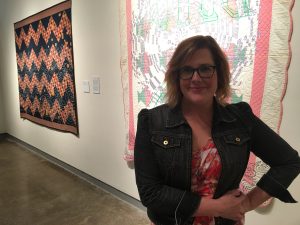A sign taped to the door of the entrance to the DePree Art Gallery warns viewers that what they are about to see is disturbing and horrific. What they are about to see is simply hate-filled and hateful.
But thankfully, that’s not all it is. What the viewer is about to see as they descend into the lower-level gallery is also hope-filled and hopeful. Hate will not have the final say in this space, the viewer will find, because Dr. Heidi Kraus will not let it.

From these diametric opposites then, the first exhibit in DePree has opened the academic year at Hope with a continued and much-needed discussion about race in America. Hateful Things|Resilience provides visitors the opportunity to consider our country’s regrettable past and present in regard to race relations, and to move on to an expectant future. “And there is no better time than now to do so,” notes Kraus, referencing the racial tensions that imbued the nation over the past two years from Ferguson, MO, to NFL player Colin Kaepernick, to this year’s presidential election.
Hateful Things|Resilience is really two exhibits in one space: historical artifacts from the Jim Crow Museum of Racist Memorabilia at Ferris State University, curated by Dr. David Pilgrim, on one-side of the gallery and on the other, a contemporary, fine art response to that memorabilia curated by Kraus. The artistic change from one side of the gallery to the other is immense as upsetting 19th and 20th century ephemera gives way to the permanency of artistic optimism and a call for change.
After seeing artifacts from the Jim Crow Museum two years ago, Kraus, profoundly upset but educationally minded, “knew it was important that there be a contemporary fine arts response to hateful things,” she says. In knowing about a heart-breaking past as well as her own current privilege, Kraus had to respond — needed to respond — in an artful way. With an art historian’s skill set and an educational gallery at her disposal, Kraus worked to secure just the right resilient artworks by African American artists from Hope’s permanent collection to combat Hateful Things from FSU. She also was able to secure two quilts by Sanford Biggers, courtesy of Monique Meloche Gallery in Chicago. The curator won a huge coup for the exhibit.
“Artists look to the past to inform their work today. Every artist who created these works in Resilience is very well aware of what exists in the other space, in the Hateful Things space,” she says, gesturing past the physically and metaphorically broken partition that divides the gallery. “But they’ve gone beyond that. It’s informed who they are, and they show that hateful things do not have the last word.”
Biggers is a highly renowned interdisciplinary African American artist, and his works in DePree show the defiance of the Underground Railroad via the resilience of contemporary art today. Given to Biggers by descendants of slaves, his quilts were once used as a coded language. Slaves seeking freedom would know if a home was a safe space to stay depending on a quilt’s color and pattern, and in the way in which it was folded on a clothesline.
“And Sanford Biggers recoded those quilts by adding a layer on top of his own,” explains Kraus. “He is directly responding to the original historical context of these items, but he has done so in a deliberately contemporary way by his choice of material and subject matter.
“Artists look to the past to inform their work today. Every artist who created these works in Resilience is very well aware of what exists in the other space, in the Hateful Things space,” she says, gesturing past the physically and metaphorically broken partition that divides the gallery. “But they’ve gone beyond that. It’s informed who they are, and they show that hateful things do not have the last word.”
Kraus is quick to credit other Hope faculty who made Hateful Things|Resilience a team effort and collaborated with her in order to get the full message across with clarity as well as discomfort. Vanessa Greene, director of the Center for Diversity and Inclusion, Dr. Lorna Jarvis Hernandez and Dr. Chuck Green from the psychology department, Dr. Dr. Jeanne Petit from the history department, and Dr. Deidre Johnston from the communication department all “walked alongside me in this, and I didn’t want to do them wrong. I wanted to be sure I had my ducks in a row and if we were going to do this at this school, we were going to do it right.”
‘Dr. Kraus, do you know why this means so much?… You are not just focusing on the downtrodden history of the African American but you are also focusing on their resilience.’ Thus the exhibition title.”
So far, the feedback has been nothing but positive. It’s a good reminder to Kraus that the difficult message she envisioned two years ago and worked to teach today was not meant to remain in her own mind and heart but rather it was meant to impact others. Especially Hope students.
“I had a lunch date with Curissa Sutherland-Smith, a junior psych major who is the president of the Black Student Union and just a beautiful soul,” remembers Kraus. “I was telling her how I was struggling with my privilege while putting this exhibit together and she stopped me and asked, ‘Dr. Kraus, do you know why this means so much?… You are not just focusing on the downtrodden history of the African American but you are also focusing on their resilience.’ Thus the exhibition title. She gave that to me, and so much more.”
From the mind and heart of a Hope student to the mind, heart and hands of a Hope professor, the necessary lessons to be learned by Hateful Things|Resilience will remain on display in the DePree Art Gallery until Friday, October 7.

